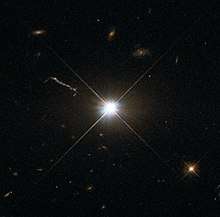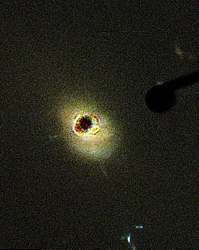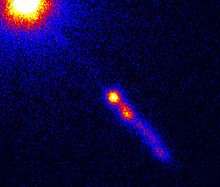3C 273
3C 273 is a quasar located in the constellation of Virgo. It was the first quasar ever to be identified.
| 3C 273 | |
|---|---|
 Quasar 3C 273 taken by Hubble Space Telescope.[1] | |
| Observation data (Epoch J2000) | |
| Constellation | Virgo |
| Right ascension | 12h 29m 06.7s[2] |
| Declination | +02° 03′ 09″[2] |
| Redshift | 0.158339 ± 0.000067[2] |
| Distance | 2.443 Gly (749 Mpc)[3][4] (luminosity distance) |
| Type | Blazar; Sy1[2] |
| Apparent magnitude (V) | 12.9[2] |
| Notable features | optically-brightest quasar, first spectrum of a quasar |
| Other designations | |
| PGC 41121[2] and HIP 60936 | |
| See also: Quasar, List of quasars | |
It is the optically brightest quasar in the sky from Earth (m ~12.9), and one of the closest with a redshift, z, of 0.158.[5] A luminosity distance of DL = 749 megaparsecs (2.4 Gly) may be calculated from z.[4] It is also one of the most luminous quasars known, with an absolute magnitude of −26.7,[6] meaning that if it were only as distant as Pollux (~10 parsecs) it would appear nearly as bright in the sky as the Sun. Since the sun's absolute magnitude is 4.83, it means that the quasar is over 4 trillion times more luminous than the Sun at visible wavelengths. The mass of its central black hole has been measured to be 886 ± 187 million solar masses through broad emission-line reverberation mapping.[7]
Large-scale jet
The quasar has a large-scale visible jet, which measures ~200 kly (60 kpc) long, having an apparent size of 23″.[4] In 1995, optical imaging of the jet using the Hubble Space Telescope revealed a structured morphology evidenced by repeated bright knots interlaced by areas of weak emission.[4]
History
The name signifies that it was the 273rd object (ordered by right ascension) of the Third Cambridge Catalog of Radio Sources (3C), published in 1959. After accurate positions were obtained using lunar occultation by Cyril Hazard at the Parkes Radio Telescope,[8] the radio source was quickly associated with an optical counterpart, an unresolved stellar object. In 1963, Maarten Schmidt[5] and Bev Oke[9] published a pair of papers in Nature reporting that 3C 273 has a substantial redshift of 0.158, placing it several billion light-years away.
Prior to the discovery of 3C 273, several other radio sources had been associated with optical counterparts, the first being 3C 48. Also, many active galaxies had been misidentified as variable stars, including the famous BL Lac, W Com, and AU CVn. However, it was not understood what these objects were, since their spectra were unlike those of any known stars. Its spectrum did not resemble that of any normal stars with typical stellar elements. 3C 273 was the first object to be identified as a quasar—an extremely luminous object at an astronomical distance.

3C 273 is a radio-loud quasar, and was also one of the first extragalactic X-ray sources discovered in 1970. However, even to this day, the process which gives rise to the X-ray emissions is controversial.[4] The luminosity is variable at nearly every wavelength from radio waves to gamma rays on timescales of a few days to decades. Polarization with coincident orientation has been observed in radio, infrared, and optical light being emitted from the large-scale jet; these emissions are therefore almost certainly synchrotron in nature,[4] radiation that is created by a jet of charged particles moving at relativistic speeds. Such jets are believed to be created by the interaction of the central black hole and the accretion disk. VLBI radio observations of 3C 273 have revealed proper motion of some of the radio emitting regions, further suggesting the presence of relativistic jets of material.[10][11]
Host galaxy
3C 273 lies at the center of a giant elliptical galaxy with an apparent magnitude of 16 and an apparent size of 30 arc seconds.[12]
Observation

3C 273 is visible in May in both the northern and southern hemispheres. Situated in the Virgo constellation, It is bright enough to be observed with larger amateur telescopes. Due in part to its radio luminosity and its discovery as the first identified quasar, 3C 273's right ascension in the Fifth Fundamental Catalog (FK5) is used to standardize the positions of 23 extragalactic radio sources used to define the International Celestial Reference System (ICRS).[13]
Given its distance from Earth and visual magnitude, 3C 273 is the most distant celestial object average amateur astronomers are likely to see through their telescopes.
References
- "Best image of bright quasar 3C 273". ESA/Hubble Picture of the Week. Retrieved 20 November 2013.
- "NASA/IPAC Extragalactic Database". Results for 3C 273. Retrieved 2006-10-26.
- "3C 273". XJET: X-Ray Emission from Extragalactic Radio Jets. 2008-01-11. Retrieved 2010-04-05.
- Uchiyama, Yasunobu; Urry, C. Megan; Cheung, C. C.; Jester, Sebastian; Van Duyne, Jeffrey; Coppi, Paolo; et al. (2006). "Shedding New Light on the 3C 273 Jet with the Spitzer Space Telescope". The Astrophysical Journal. 648 (2): 910–921. arXiv:astro-ph/0605530. Bibcode:2006ApJ...648..910U. doi:10.1086/505964.
- Schmidt, M. (1963). "3C 273 : A Star-Like Object with Large Red-Shift". Nature. 197 (4872): 1040. Bibcode:1963Natur.197.1040S. doi:10.1038/1971040a0.
- "The Quasi-Stellar Radio Sources 3C 48 and 3C 273". The Astrophysical Journal. Bibcode:1964ApJ...140....1G. doi:10.1086/147889. Retrieved 25 April 2014.
- Peterson, B. M.; Ferrarese, L.; Gilbert, K. M.; Kaspi, S.; Malkan, M. A.; Maoz,D.; et al. (2004). "Central Masses of AGNs. II". The Astrophysical Journal. 613 (2): 682–699. arXiv:astro-ph/0407299. Bibcode:2004ApJ...613..682P. doi:10.1086/423269.
- Hazard, C.; Mackey, M. B.; Shimmins, A. J. (1963). "Investigation of the Radio Source 3C273 by the method of Lunar Occultations". Nature. 197 (4872): 1037. Bibcode:1963Natur.197.1037H. doi:10.1038/1971037a0.
- Oke, J. B. (1963). "Absolute Energy Distribution in the Optical Spectrum of 3C 273". Nature. 197 (4872): 1040. Bibcode:1963Natur.197.1040O. doi:10.1038/1971040b0.
- Pearson, T. J.; Unwin, S. C.; Cohen, M. H.; Linfield, R. P.; Readhead, A. C. S.; Seielstad, G. A.; Simon, R. S.; Walker, R. C. (1981). "Superluminal expansion of quasar 3C273". Nature. 290 (5805): 365. Bibcode:1981Natur.290..365P. doi:10.1038/290365a0.
- Davis, R. J.; Unwin, S. C.; Muxlow, T. W. B. (1991). "Large-scale superluminal motion in the quasar 3C273". Nature. 354 (6352): 374. Bibcode:1991Natur.354..374D. doi:10.1038/354374a0.
- Bahcall, John N.; Kirhakos, Sofia; Saxe, David H.; Schneider, Donald P. (1997). "Hubble Space Telescope Images of a Sample of 20 Nearby Luminous Quasars". The Astrophysical Journal. 479: 642. arXiv:astro-ph/9611163. Bibcode:1997ApJ...479..642B. doi:10.1086/303926.
- International Earth Rotation & Reference Systems Service. "Definition of ICRS Axes". Retrieved 11 January 2012.
External links
- 3C 273's Database at the INTEGRAL Science Data Centre (ESA)
- Detailed CCD image of 3C 273 based on 30 min total exposure
- Amateur 3C 273 Redshift Measurement
- NightSkyInfo.com – 3C 273
- SKY-MAP.ORG SDSS image of 3C 273
- The Quasar 3C 273: Spring 2005 – Variable Star Of The Season AAVSO
- 3C 273 on WikiSky: DSS2, SDSS, GALEX, IRAS, Hydrogen α, X-Ray, Astrophoto, Sky Map, Articles and images